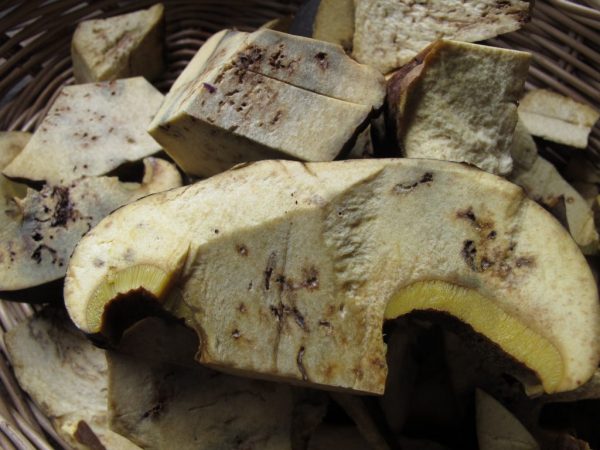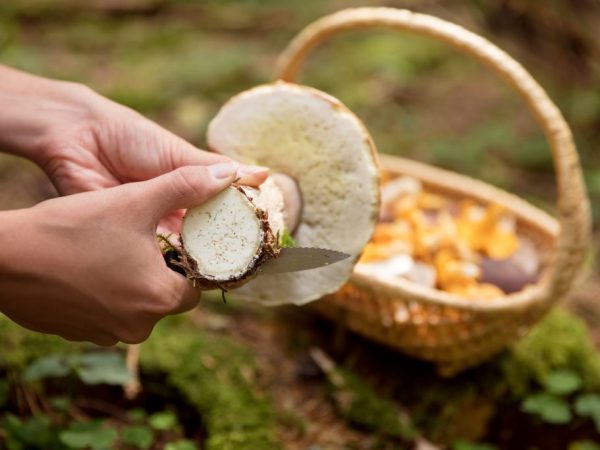Is it possible to eat wormy mushrooms
The main goal of every mushroom picker "quiet hunt" is to get ecologically clean, tasty and healthy gifts of nature. But sometimes wormy or poisonous mushrooms come across, so you need to be able to distinguish one from the other.

Is it possible to eat wormy mushrooms
Mushroom picking rules
The main rules, the observance of which will help to make mushroom picking as easy and successful as possible:
- Mushrooms are harvested in forests or at their edges. Ask other mushroom pickers about their favorite picking spots. Or use a mushroom map of the area.
- The equipment of the mushroom picker should be light and comfortable, the knife should be sharp and, as they say, “on the hand”, and a wicker basket in which there is a constant movement of air is suitable for transporting mushrooms.
- The best time to harvest is early morning, when the sun's rays have not yet dried the dew on the caps of the fruit bodies.
- It is better to pick those mushrooms in the edibility of which you are completely sure. Those that cause even the slightest doubt should be thrown away so as not to spoil the entire harvested crop.
- To preserve the mycelium, it is better to cut the mushrooms at the base or gently twist them out of the ground. After that, it is advisable to sprinkle the place of cut (twisting) with earth.
- Preference should be given to young mushrooms without damage. Do not rush to throw away slightly wormy mushrooms. They can be folded separately or, after removing the damage, they can also be sent to the basket.
- The cut mushroom is carefully inspected and soil and debris removed. It is preferable to put them in a basket, caps down, to save space and prevent breakage and damage. In addition, larger and heavier specimens are usually placed down the baskets, and small and light ones are placed on top.
- It is better to process the harvested crop immediately after returning. From long storage, they deteriorate and lose their taste.
Signs of a wormy mushroom
Often during the "quiet hunt" comes across a fruiting body to some extent damaged by worms or other insects. To decide whether it is possible to use the wormy mushroom in the future, determine the reasons for this process.
The worms that settle in them are insect larvae hatched from eggs laid on its surface. For the mycelium, they play an important role - they eat the fruit body and carry spores underground, contributing to their spread.
The only edible mushroom that can never be wormy is the chanterelle. This is due to the presence in it of a substance that is deadly to pests, which is a natural antihelmintic - quinomannosis. Humid and warm weather is believed to be conducive to the spread of worms.

It is better to cut off the affected areas.
To determine whether the mushroom is wormy, carefully examine its surface and the place of the cut. By the presence of irregularities, holes and clearly prominent "passages" of worms, determine the degree of its defeat. Then there are the following options for action:
- only the cut site is damaged: try to remove this part down to the cap, and the rest can be cooked and eaten;
- small upper part damaged: it is neatly trimmed and discarded;
- 1-2 lesions: the mushroom is taken with them, and at home they are treated in a special way before cooking;
- deep damage to the fungus by worms: they get rid of it, and it is better to do this by pricking it on a branch so that, after drying, the spores can be sprayed over a larger area.
Eating
A wormy mushroom does not cause poisoning, unlike a poisonous or inedible fruit body. Usually old, overgrown specimens are affected by these pests. But these lose most of their taste, the pulp is tough or too loose with an unpleasant aroma. If you eat such a specimen, it will lead to significant indigestion and intoxication of the body.
Irina Selyutina (Biologist):
Many gastroenterologists are sure that there is no need to eat wormy mushrooms, because worms produce toxins that are practically impossible to remove from the fungus either by heat treatment or by saline. In their opinion, only lamellar mushrooms can be saved, which have a dense structure of the fruiting body and it is not difficult to cut out the affected areas. But it is better to leave wormy tubular mushrooms in the forest - it will not work to completely remove the worms even by cutting out the affected parts.
If a mushroom picker has a spoiled boletus, boletus, oil can in the hands of a mushroom picker, it is worth making a little effort and preparing it for use. For this, the fruit body is cut into large pieces and poured with a solution of salt water. After 2-3 hours, when the pests emerge, the mushrooms are removed from the solution. Attention! Mushrooms are removed, not drained. They do this in order not to leave pests on the bottom of the dishes. Then they are thoroughly washed, dried and prepared for use in the chosen way. You can use a more concentrated solution - for 3 liters of water 2 tbsp. l. salt and leave the mushrooms for 30-40 minutes.
Another way to use mushrooms damaged by worms is to dry them. In this process, almost immediately, the parasites will leave the withering fruit bodies on their own, having lost the nutrient medium for their existence. Later, before cooking, the mushrooms are thoroughly washed.
Irina Selyutina (Biologist):
What can be said about perhaps two of the most common mushrooms:
- Honey mushroom: this mushroom can be called, perhaps, the most "understandable" in terms of worminess: it always "speaks" the truth. If you see holes in the cut, just cut the leg as close to the cap as possible. Usually in these mushrooms the worms finish building "catacombs" at the approaches to the cap. And it is used for food.
- Butterlets: almost always worms, especially if you are late with the collection time (within a day after regrowth).
The larvae (worms) have excellent appetite. If you brought home a wormy mushroom and for some reason postponed the "joy" of processing a little "for later", then by the time of processing it can already serve as a sieve in the kitchen. Therefore, it is best to cut out the wormy parts immediately at the collection point and put the "clean" ones in the basket.
By removing the wormy parts of the mushroom right in the forest, you save your work, because having eaten your cozy "house", the worms will quickly move to a nearby free "dwelling". In this case, the mushroom picker will bring home more wormy mushrooms than he collected.
Conclusion
The presence of worms in the harvested mushrooms does not make them poisonous. Eating wormy mushrooms or not is a personal matter for every mushroom picker. Such mushrooms can spoil the aesthetic impression, but with proper processing (removing all the affected parts as far as possible) they can be eaten, because they will not spoil the taste of the dish and will allow you to enjoy it to the fullest.



